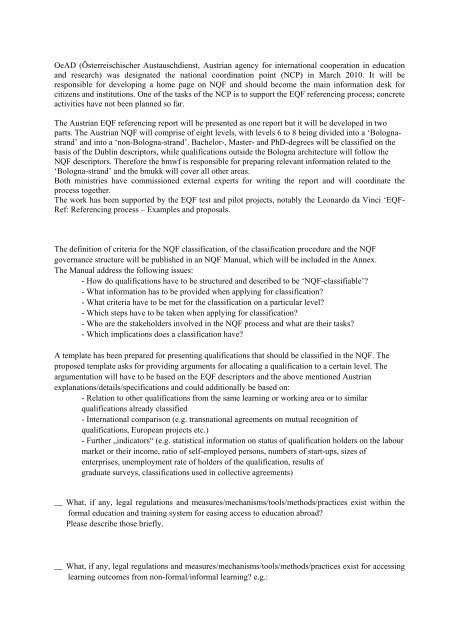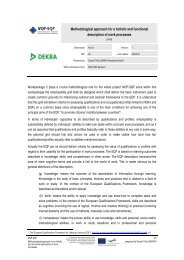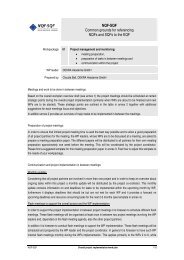Overview of National Qualification frameworks - Project-Nqf-Sqf
Overview of National Qualification frameworks - Project-Nqf-Sqf
Overview of National Qualification frameworks - Project-Nqf-Sqf
You also want an ePaper? Increase the reach of your titles
YUMPU automatically turns print PDFs into web optimized ePapers that Google loves.
OeAD (Österreischischer Austauschdienst, Austrian agency for international cooperation in educationand research) was designated the national coordination point (NCP) in March 2010. It will beresponsible for developing a home page on NQF and should become the main information desk forcitizens and institutions. One <strong>of</strong> the tasks <strong>of</strong> the NCP is to support the EQF referencing process; concreteactivities have not been planned so far.The Austrian EQF referencing report will be presented as one report but it will be developed in twoparts. The Austrian NQF will comprise <strong>of</strong> eight levels, with levels 6 to 8 being divided into a ‘Bolognastrand’and into a ‘non-Bologna-strand’. Bachelor-, Master- and PhD-degrees will be classified on thebasis <strong>of</strong> the Dublin descriptors, while qualifications outside the Bologna architecture will follow theNQF descriptors. Therefore the bmwf is responsible for preparing relevant information related to the‘Bologna-strand’ and the bmukk will cover all other areas.Both ministries have commissioned external experts for writing the report and will coordinate theprocess together.The work has been supported by the EQF test and pilot projects, notably the Leonardo da Vinci ‘EQF-Ref: Referencing process – Examples and proposals.The definition <strong>of</strong> criteria for the NQF classification, <strong>of</strong> the classification procedure and the NQFgovernance structure will be published in an NQF Manual, which will be included in the Annex.The Manual address the following issues:- How do qualifications have to be structured and described to be ‘NQF-classifiable’?- What information has to be provided when applying for classification?- What criteria have to be met for the classification on a particular level?- Which steps have to be taken when applying for classification?- Who are the stakeholders involved in the NQF process and what are their tasks?- Which implications does a classification have?A template has been prepared for presenting qualifications that should be classified in the NQF. Theproposed template asks for providing arguments for allocating a qualification to a certain level. Theargumentation will have to be based on the EQF descriptors and the above mentioned Austrianexplanations/details/specifications and could additionally be based on:- Relation to other qualifications from the same learning or working area or to similarqualifications already classified- International comparison (e.g. transnational agreements on mutual recognition <strong>of</strong>qualifications, European projects etc.)- Further „indicators“ (e.g. statistical information on status <strong>of</strong> qualification holders on the labourmarket or their income, ratio <strong>of</strong> self-employed persons, numbers <strong>of</strong> start-ups, sizes <strong>of</strong>enterprises, unemployment rate <strong>of</strong> holders <strong>of</strong> the qualification, results <strong>of</strong>graduate surveys, classifications used in collective agreements)__ What, if any, legal regulations and measures/mechanisms/tools/methods/practices exist within theformal education and training system for easing access to education abroad?Please describe those briefly.__ What, if any, legal regulations and measures/mechanisms/tools/methods/practices exist for accessinglearning outcomes from non-formal/informal learning? e.g.:




